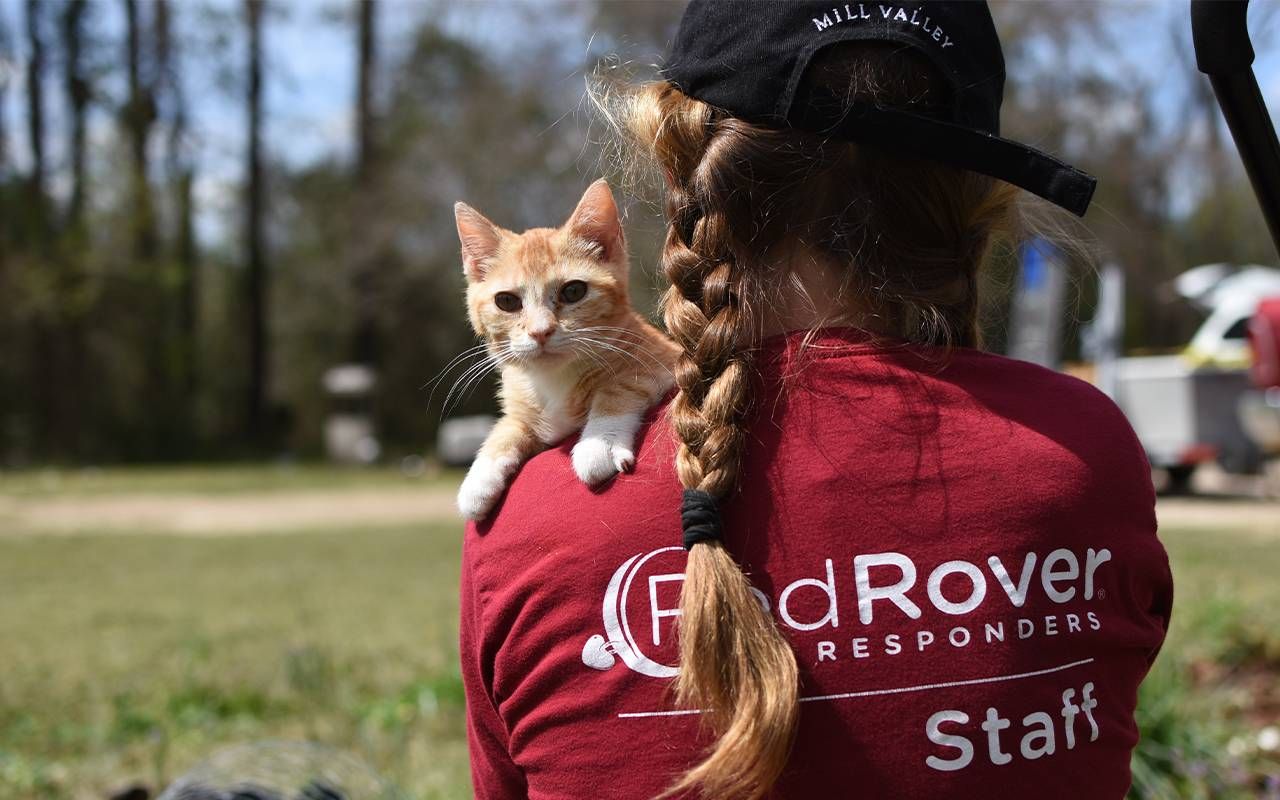Bringing Animals Into Care
Across the U.S., RedRover volunteers serve animals and communities in disasters and other times of need
When Hurricane Ian ripped across central Florida in the early autumn last year, it was responsible for more than 150 direct and indirect deaths and in excess of $112 billion in damage, making it the costliest hurricane in Florida's history, according to the National Hurricane Center.
It also displaced hundreds of pets, leaving them to fend for themselves in an unrecognizable urban environment.

"It was like a war zone," said Beth Gammie, 59, director of field services for RedRover, a Sacramento, California-based nonprofit that arranged teams of volunteers to care for pets displaced by the storm.
"We do emergency animal sheltering for natural disasters and large-scale cruelty seizures."
While the Red Cross and other agencies tend to the needs of people in natural disasters, pets are often not accommodated at the same emergency shelters. Local humane societies and other volunteer relief agencies step in to fill that gap.
In Hawaii, individual volunteers have stepped in after the authorities asked animal-welfare nonprofits to postpone their work while recovery teams search for the remains of humans who died in the blaze.
RedRover coordinates with local emergency agencies to build temporary shelters, care for animals of all types and reunite pets with their families. In photographs of animal rescues following storms and wildfires, it's easy to identify RedRover volunteers — they are the ones wearing dark red T‑shirts.
"We do emergency animal sheltering for natural disasters and large-scale cruelty seizures," Gammie explained.
4,000 Beagles
Those seizures may be from cases of animal hoarding, dog fighting or puppy mills. In 2022, RedRover volunteers helped to care for about 4,000 beagles that a private company, Envigo RMS LLC, gave away to settle allegations of animal cruelty at its facility in Cumberland, Virginia, which bred dogs to be sold to laboratories for animal experiments.
RedRover has trained 4,600 "Responders," its name for volunteers, who have deployed to more than 240 situations in the last 30 years. In puppy mill and hoarding cases, the greatest reward comes from the animals.
"You can see in a couple of days, the animals know they're not going back there," Gammie said.
Volunteer Tom Anderson, 69, witnessed a change in attitude among the beagles in Virginia. "To watch the older beagles decompress, then realize that they were free to be dogs, and then to follow their progress as they went to rescue partners for adoptions, was extremely impactful," he said.
Reuniting Pets and Owners
Animals also show a positive response in temporary shelters after natural disasters. During the 2022 fires in El Dorado County, California, Responders assisted with pets and other animals. "It feels really great to get the dogs out, to walk them and take care of them, and then they go home with their owners, if they have owners," Gammie said.
RedRover is unique in its role with animals in emergencies. Although the Humane Society of the United States and American Society for the Prevention of Cruelty to Animals have large staffs who work on large cases, RedRover has the flexibility to work in large or small situations.
Its teams, volunteer-based with only one or two RedRover staff members onsite, may put together temporary shelters with fencing and crates. Their focus is to feed, exercise and comfort animals.
"We help animals come from the back of the cage to the front of the cage."
Emergencies are as stressful for animals as for humans. In Virginia, where many of the 4,000 beagles, including puppies, had been confined with little human interaction, RedRover volunteers offered lots of hugs.
"We help animals come from the back of the cage to the front of the cage," said Susie Robert, 46, RedRover's Interim CEO. "We see that confidence growing because of their care."
Some of RedRover's deployments are planned projects, not emergencies. Responders participate in pet vaccination clinics and in trap-neuter-release programs, often in communities without a lot of animal-welfare resources.
RedRover also builds permanent animal shelters at domestic violence centers across the country. Research shows abusers often have a pattern of violence toward all members of the household, including children and pets.
Bring Pets from Crisis to Care
Nearly half of victims stay in abusive situations rather than leave pets behind, according to researchers at The Foundation for Interdisciplinary Research and Education Promoting Animal Welfare, a nonprofit in Seattle. Until recently, shelters would house women and children, but there were few options for pets.

Responders who work to build animal shelters at domestic violence centers never see the animals who will live there, but Gammie said the work uniquely exemplifies RedRover's tagline — "bringing animals from crisis to care."
Anderson, who lives in Flower Mound, Texas, near Dallas, appreciates that mission. "To see a plan come together, whether it be assisting with an animal seizure case or helping with keeping animals safe in different types of communities, I've always come away from a deployment looking forward to the next opportunity to help," he said.
Tom's daughter Jennifer, 44, who also volunteers, agrees. "It fills my heart to see not only the dogs but also the families light up with joy. It also provides me more opportunities to volunteer with my dad."
Much-Loved Volunteers
Just as Responders love what they do, they are loved by the people and animals they serve.
The lead agencies, those that ask RedRover for help, appreciate the training and enthusiasm of the visiting Responders. In some cases, the lead agency is the Humane Society of the United States. In other cases, it is a city, county or local law enforcement jurisdiction.
"They may not have known how to set up a huge pet shelter (when RedRover arrived), but by the time we leave, they will."
Some local emergency agencies know about RedRover, but Gammie actively contacts those who might need services. Her department tracks natural disasters and reaches out to let emergency managers know volunteers are available.
"We come in and we're cheerful," Gammie said. "We're good partners. We work hard. We're easy to work with."
And the community learns something. "They see this army of volunteers come in and help and do such a good job because we've done this before," Gammie said. "They may not have known how to set up a huge pet shelter, but by the time we leave, they will."
Responders get as much from the experience as they give.
"Being a RedRover Responder has allowed me to stretch my abilities into areas that I never thought that I could do," Tom Anderson said, "and to participate as an integral part of the RedRover team."
Jennifer Anderson feels it, too. "What makes RedRover satisfying is helping communities in need that are outside of my own community. It provides me the opportunity to experience other cultures and work with new people, while helping furry family members."
Want to Be a RedRover Responder?
RedRover has a lot of volunteers, but Gammie said there are not enough to take care of the needs and the organization is always looking for more.
Before deployment, Responders receive online training and complete an online certification program from the Federal Emergency Management Agency. The training introduces volunteers to the Incident Command System, or ICS. Police agencies, fire departments, emergency managers and other national groups that respond to animal emergencies use the same system.
Responders are given responsibilities that match their skillsets. No experience is required. An invitation to deploy arrives via email with a description of the location, duties involved, time commitment (often one to three days, but may be longer) and the housing situation. A travel stipend is included. Gammie said it's quite alright to decline.
Compassion is key in RedRover's work, she added. "At the highest level, it's just how important compassion is, between ourselves, the people and the animals."


